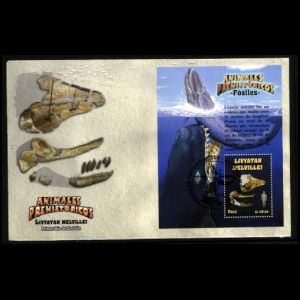Peru 2011 "Prehistoric animals – Levyatan melvillei"
| <prev | back to index | next> |
| Issue Date | 17.10.2011 |
| ID | Michel: Bl. 74; Scott: 1798; Stanley Gibbons: MS2822; Yvert et Tellier: Category: pF |
| Design | Christian Alvarez M. - Serpost S.A. |
| Stamps in set | 1 |
| Value | S/. 10,00 - Levyatan melvillei |
| Emission/Type | commemorative |
| Issue place | Lima |
| Size (width x height) | stamp: 40 mm x 30 mm, Souvenir-Sheet: 80 mm x 104 mm |
| Layout | Block with one stamp |
| Products | FDC x1 |
| Paper | |
| Perforation | 14 x 13.5 |
| Print Technique | Offset, polichromy |
| Printed by | Thomas Greg and Sons - Peru |
| Quantity | 10.000 |
| Issuing Authority | Servicios Postales del Peru SA |

On October 17 th, 2011, the Post Authority of Peru - Servicios Postales del Peru SA (Serpost) - continued their multi-year series "Prehistoric animals - Fossils" (Animales Prehistoricos - Fosiles) started in 2004.
This year the Souvenir-Sheet shows scientific reconstruction and fossil of prehistoric sperm whale - Levyatan melvillei.
The reverse side of the Souvenir-Sheet is numbered.
In November 2008, fossil remains of a giant, prehistoric whale were discovered, by international paleontologists team, in the middle of the Peruvian desert 35 km south-west of the city of Ica, from the Pisco Formation at Cerro Colorado, Peru.
Klaas Post, a researcher for the Natural History Museum Rotterdam in the Netherlands, stumbled across them on the final day of a field trip.
 |
The species was described two years later and named Livyatan melvillei, after the original Hebrew word for a mythical sea monster - Livyatan - and Herman Melville (1819–1891), the author of the novel Moby Dick, about a white bull sperm whale.
The teeth of Livyatan melvillei were so large, each around 12 centimetres in diameter and up to 36 centimetres in length, it was initially assumed they were elephant tusks. However, there were no elephants in South America before 3 million years ago, while the specimens found have an estimated age between 9 and 10 million years old.
Professor Jelle Reumer from Natural History (Natuurhistorisch) Museum Rotterdam, the Netherlands, one of the team of scientists who found the fossil explained:
The size of its teeth indicate that the mammal fed on large prey,
possibly baleen whales which were plentiful at the time of the
Livyatan's existence around 12 million to 13 million years ago, in the
middle of the Miocene Age.
After the Miocene it became relatively much colder.
At the same time the baleen whales became bigger probably to escape from predation from
these animals, just the way elephants escaped predation by becoming
bigger so they were not eaten by lions any more.
Livyatan melvillei was a cetacean that measured about 15 meters in length. It was a close relative of modern sperm whales, but unlike those whose diet is based on squid, the Livyatan was possibly the maximum predator of the food chain thanks to its powerful bite and enormous size. Paleontologists think that the evolution of this hypercarnivore was favoured by the great diversity of whales that occurred at that time and that constituted its main food.
 |
| Prehistoric shark Carcharocles megalodon on Souvenir-Sheet of New Caledonia 1999, MiNr.: Bl. 22, Scott: 818. |
Livyatan differs from current sperm whales in
This great predator coexisted with another colossus of the time, the giant shark Carcharocles megalodon, whose size is estimated at 13 meters. Teeth up to 15 cm long of Carcharocles are relatively common in the area where fossils of Livyatan were discovered. As a top predator, together with the contemporaneous giant shark Carcharocles megalodon, it probably had a profound impact on the structuring of Miocene marine communities.
The fossil of Livyatan melvillei were prepared in Lima, and now are in collection of the Department of Vertebrate Paleontology of the Museo de Historia Natural, Universidad Nacional Mayor de San Marcos, Lima - Peru, under specimen number MUSM 1676.
Casts of three largest teeth are on display at the Natural History Museum Rotterdam, the Netherlands.
Products and associated philatelic items
| FDC | First-Day-of-Issue Postmark | Example of circulated cover |
 |
 |
 |

|

|
References
- Technical details and stamps presentation:
Serpost Brochure colnect -
Levyatan melvillei:
Wikipedia. -
Discovery of Levyatan melvillei in Peru:
- CNN: 'Sea monster' fossil found in Peru desert
- BBC: 'Sea monster' whale fossil unearthed
- It's Nature: Leviathan melvillei
- Lambert, O., Bianucci, G., Post, K. et al. "The giant bite of a new raptorial sperm whale from the Miocene epoch of Peru". Nature 466, 105–108 (2010). https://doi.org/10.1038/nature09067
-
Museum of Natural History, Lima
official website, Wikipedia
Acknowledgements
Many thanks to Dr. Peter Voice from Department of Geological and Environmental Sciences, Western Michigan University, for reviewing the draft page and his very valuable comments.| <prev | back to index | next> |